You are using an out of date browser. It may not display this or other websites correctly.
You should upgrade or use an alternative browser.
You should upgrade or use an alternative browser.
Time for another DIY Speaker project
- Thread starter captrajesh
- Start date
Usually man proposes and God disposes. But here, taking the speakers back with me by road is what I proposed but cabinet maker had disposed it. LOL.Great!
capt... finally things seem to be progressing well with the source (cabinet maker)
He had marriage happening in his family. So couldn't help it.
Just interacted with the cabinet maker. He's suggesting that I place the Aluminium layer internally with damping material in between. Reduction in volume would not be much that it would matter he says.The deal was to make fully finished cabinets but the idea of CLD is still lingering in my mind! Since it's already made of a thick 19mm MDF, will a 2-3mm outer Aluminium layer with a damper in between have the qualities of CLD cabinet?
What say gurus?
If he has has stuck to the original enclosure size and design, it takes care of the internal box volume and also the driver displacements.The internal box imo consume atleast 30% of the box volume. It could impact the overall volume required for the woofer.
Damping is important to prevent reflections from the Alu layer.Just interacted with the cabinet maker. He's suggesting that I place the Aluminium layer internally with damping material
You can use multiple layers of 10mm felt (Namda pads) if you are averse to glass or rock wool.
https://www.amazon.in/Acoustic-Eco-Felt-10mm-Multicolour/dp/B08MQHWWSB
Last edited by a moderator:
am no expert but I would suggest to strictly follow the speaker designers specifications. Reduced volume will affect response of low end and tuned port matching. Usually with reduced internal volume you loose some extension if driver is matched to it.Just interacted with the cabinet maker. He's suggesting that I place the Aluminium layer internally with damping material in between. Reduction in volume would not be much that it would matter he says.
regards
3mm Aluminium sheet on the six sides would gobble up 30% internal volume!!! Are you sure @Hari Iyer ?The internal box imo consume atleast 30% of the box volume. It could impact the overall volume required for the woofer.
That's given @Kannan It has to be lined with glass/ rock wool or recron or namda to absorb the standing waves. Would Aluminium lining inside the speakers be conducive from the SQ point of view is what I'm asking.Damping is important to prevent reflections from the Alu layer.
You can use multiple layers of 10mm felt (Namda pads) if you are averse to glass or rock wool.
That's what I'm thinking too @Hiten. But the person who's making my cabinet and giving the suggestion is a renowned speaker maker. Hence the dilemma.am no expert but I would suggest to strictly follow the speaker designers specifications. Reduced volume will affect response of low end and tuned port matching. Usually with reduced internal volume you loose some extension if driver is matched to it.
If you are only bracing the corners and not the entire face of the wood, it will not matter. You can additionally apply silicon over the entire alu lining and cover with whatever damping material you will use.Aluminium lining inside the speakers be conducive from the SQ point of view is what I'm asking.
If you want to avoid alu, then use 1 to 1.5 inch wooden wedges in all cornes, joints and central areas.
ahh. then its OK. Practical implmentation/experience also should be taken in to consideration. Probably one can get away with not so thick inner panel so as not to change internal volume significantly.That's what I'm thinking too @Hiten. But the person who's making my cabinet and making the suggestion is a renowned speaker maker. Hence the dilemma.
regards.
Vineethkumar01
Well-Known Member
I have doubts as to what is the impact of thin aluminum sheets with respect to reducing "unwanted" sound radiation from the speaker. The following is my current limited knowledge regarding this aspect in general (I have really limited knowledge in this area. please take my opinion here with this consideration).
We need to reduce panel vibrations and acoustical resonances inside the cabinet. In reducing panel vibrations at lower frequencies, stiffness helps. By making the box as stiff as possible, we are pushing the unwanted colorations from panel vibrations to higher frequencies ideally out of the passband of the driver that is causing this issues. From this point of view, a really stiff cabinet is the better choice for a woofer cabinet. As the passband of the woofer driver consists of the lower frequencies, by making the box stiff, we can push the panel vibration induced colorations to the midrange band where the woofer (due to the crossover to the mid) produces lesser and lesser energy and therefore causes less unwanted excitation of the panels in the lower frequencies.
By properly damping or mass loading a box, we are pushing the 'unwanted' vibrations lower in frequency. Intuitively, such a scheme helps with a midrange box. Due to the high pass filter employed on a mid at the lower frequency range, the midrange produces lesser energy as we go down in frequency and therefore is less likely to excite the unwanted modes if we have pushed them down enough in frequency. Mass loading via appropriate scheme (rubber sheets, bitumen?) or damping schemes such as CLD box and CLD braces help here.
For the specific case of CLD, I have seen people saying that for CLD to work properly, two stiff layers (MDF, birchply etc used for making the box) should be on either side of a thin shearing layer (appropriate glue, some other material). For CLD to work properly, it is important that the two stiff layers are similar w.r.t certain physical parameters such as thickness/stiffness etc. So a two half inch thick MDF boards held together by a CLD glue in between will work, logically. In this context, will aluminum sheet which (may be having, not sure) has different physical properties in terms of thickness and stiffness compared to the MDF box material will work? I am doubtful regarding this. I also don't know if it will help increase the stiffness of the box which is a good attribute for a woofer box.
Acoustical resonances, standing waves etc caused by box geometry and things like ports can be tamed to some extent by taking care of the location where driver is mounted in a box (the lower frequency issues) and by appropriate filling material such as long fiber wool, fiberglass etc (the higher frequency issues). Here anyway aluminum sheet is of no help.
In short as per my understanding, CLD helps with midranges box. Making a stiff box with appropriate bracing will help a woofer box. Using damping material such as wool, dacron helps in taming acoustical resonances/standing waves. Where does thin aluminum sheets help, I have no idea.
The kind of aluminium-butyl sheets used in car audio etc may work there due to the thin sheet metal used in car doors etc by helping with some amount of CLD and mass-loading. I have seen augerpro on diyaudio highly recommending Resonix CLD tiles in speaker builds in addition to CLD schemes.
This is a very informative thread regarding all speaker building aspects in general.
 www.diyaudio.com
Fluid is a very respected member in diyaudio. He has measured impact of different damping materials from post 195 onwards. He also uses mass loading via rubber sheets etc in this particular build..
www.diyaudio.com
Fluid is a very respected member in diyaudio. He has measured impact of different damping materials from post 195 onwards. He also uses mass loading via rubber sheets etc in this particular build..
We need to reduce panel vibrations and acoustical resonances inside the cabinet. In reducing panel vibrations at lower frequencies, stiffness helps. By making the box as stiff as possible, we are pushing the unwanted colorations from panel vibrations to higher frequencies ideally out of the passband of the driver that is causing this issues. From this point of view, a really stiff cabinet is the better choice for a woofer cabinet. As the passband of the woofer driver consists of the lower frequencies, by making the box stiff, we can push the panel vibration induced colorations to the midrange band where the woofer (due to the crossover to the mid) produces lesser and lesser energy and therefore causes less unwanted excitation of the panels in the lower frequencies.
By properly damping or mass loading a box, we are pushing the 'unwanted' vibrations lower in frequency. Intuitively, such a scheme helps with a midrange box. Due to the high pass filter employed on a mid at the lower frequency range, the midrange produces lesser energy as we go down in frequency and therefore is less likely to excite the unwanted modes if we have pushed them down enough in frequency. Mass loading via appropriate scheme (rubber sheets, bitumen?) or damping schemes such as CLD box and CLD braces help here.
For the specific case of CLD, I have seen people saying that for CLD to work properly, two stiff layers (MDF, birchply etc used for making the box) should be on either side of a thin shearing layer (appropriate glue, some other material). For CLD to work properly, it is important that the two stiff layers are similar w.r.t certain physical parameters such as thickness/stiffness etc. So a two half inch thick MDF boards held together by a CLD glue in between will work, logically. In this context, will aluminum sheet which (may be having, not sure) has different physical properties in terms of thickness and stiffness compared to the MDF box material will work? I am doubtful regarding this. I also don't know if it will help increase the stiffness of the box which is a good attribute for a woofer box.
Acoustical resonances, standing waves etc caused by box geometry and things like ports can be tamed to some extent by taking care of the location where driver is mounted in a box (the lower frequency issues) and by appropriate filling material such as long fiber wool, fiberglass etc (the higher frequency issues). Here anyway aluminum sheet is of no help.
In short as per my understanding, CLD helps with midranges box. Making a stiff box with appropriate bracing will help a woofer box. Using damping material such as wool, dacron helps in taming acoustical resonances/standing waves. Where does thin aluminum sheets help, I have no idea.
The kind of aluminium-butyl sheets used in car audio etc may work there due to the thin sheet metal used in car doors etc by helping with some amount of CLD and mass-loading. I have seen augerpro on diyaudio highly recommending Resonix CLD tiles in speaker builds in addition to CLD schemes.
This is a very informative thread regarding all speaker building aspects in general.
Full Range TC9 Line Array CNC Cabinet
Interesting, looks like they have made a sandwich of an outer baffle with roundover which maybe holds the driver down and the glue acts as a gasket. How do you then isolate the face baffle from everything else? This is why I couldn't find something simple. Could you use the gasket along the...
Last edited:
keith_correa
Well-Known Member
I think the cabinet maker is suggesting a sandwich. The outer layer being the existing box, the middle layer - a damping material and the inner layer - 3mm of aluminum.If you are only bracing the corners and not the entire face of the wood, it will not matter. You can additionally apply silicon over the entire alu lining and cover with whatever damping material you will use.
If you want to avoid alu, then use 1 to 1.5 inch wooden wedges in all cornes, joints and central areas.
What damping layer is he suggesting? How thick? Is he suggesting this to mass load the walls?
Didn't get you @Kannan ji! Braces are there just behind the woofer from rear panel to half way into the cabinet and to the sides of the mid-range tunnel (two each per side). Are you implying that bracing would substitute for CLD?If you are only bracing the corners and not the entire face of the wood, it will not matter. You can additionally apply silicon over the entire alu lining and cover with whatever damping material you will use.
If you want to avoid alu, then use 1 to 1.5 inch wooden wedges in all cornes, joints and central areas.
I'm using Aluminium to add minimum thickness and adding mass as the MDF layer is already 19mm thick. Should work as CLD if I use a damping gel that you had linked earlier.I have doubts as to what is the impact of thin aluminum sheets with respect to reducing "unwanted" sound radiation from the speaker. The following is my current limited knowledge regarding this aspect in general (I have really limited knowledge in this area. please take my opinion here with this consideration).
We need to reduce panel vibrations and acoustical resonances inside the cabinet. In reducing panel vibrations at lower frequencies, stiffness helps. By making the box as stiff as possible, we are pushing the unwanted colorations from panel vibrations to higher frequencies ideally out of the passband of the driver that is causing this issues. From this point of view, a really stiff cabinet is the better choice for a woofer cabinet. As the passband of the woofer driver consists of the lower frequencies, by making the box stiff, we can push the panel vibration induced colorations to the midrange band where the woofer (due to the crossover to the mid) produces lesser and lesser energy and therefore causes less unwanted excitation of the panels in the lower frequencies.
By properly damping or mass loading a box, we are pushing the 'unwanted' vibrations lower in frequency. Intuitively, such a scheme helps with a midrange box. Due to the high pass filter employed on a mid at the lower frequency range, the midrange produces lesser energy as we go down in frequency and therefore is less likely to excite the unwanted modes if we have pushed them down enough in frequency. Mass loading via appropriate scheme (rubber sheets, bitumen?) or damping schemes such as CLD box and CLD braces help here.
For the specific case of CLD, I have seen people saying that for CLD to work properly, two stiff layers (MDF, birchply etc used for making the box) should be on either side of a thin shearing layer (appropriate glue, some other material). For CLD to work properly, it is important that the two stiff layers are similar w.r.t certain physical parameters such as thickness/stiffness etc. So a two half inch thick MDF boards held together by a CLD glue in between will work, logically. In this context, will aluminum sheet which (may be having, not sure) has different physical properties in terms of thickness and stiffness compared to the MDF box material will work? I am doubtful regarding this. I also don't know if it will help increase the stiffness of the box which is a good attribute for a woofer box.
Acoustical resonances, standing waves etc caused by box geometry and things like ports can be tamed to some extent by taking care of the location where driver is mounted in a box (the lower frequency issues) and by appropriate filling material such as long fiber wool, fiberglass etc (the higher frequency issues). Here anyway aluminum sheet is of no help.
In short as per my understanding, CLD helps with midranges box. Making a stiff box with appropriate bracing will help a woofer box. Using damping material such as wool, dacron helps in taming acoustical resonances/standing waves. Where does thin aluminum sheets help, I have no idea.
The kind of aluminium-butyl sheets used in car audio etc may work there due to the thin sheet metal used in car doors etc by helping with some amount of CLD and mass-loading. I have seen augerpro on diyaudio highly recommending Resonix CLD tiles in speaker builds in addition to CLD schemes.
Thanks so much for the link. Will go through in leisure.This is a very informative thread regarding all speaker building aspects in general.
Fluid is a very respected member in diyaudio. He has measured impact of different damping materials from post 195 onwards. He also uses mass loading via rubber sheets etc in this particular build..Full Range TC9 Line Array CNC Cabinet
Interesting, looks like they have made a sandwich of an outer baffle with roundover which maybe holds the driver down and the glue acts as a gasket. How do you then isolate the face baffle from everything else? This is why I couldn't find something simple. Could you use the gasket along the...www.diyaudio.com
Yes. That exactly did he suggest.I think the cabinet maker is suggesting a sandwich. The outer layer being the existing box, the middle layer - a damping material and the inner layer - 3mm of aluminum.
We haven't come to that yet. And I'm not convinced that adding a 2-3 mm Aluminium layer could be placed inside easily and would have enough efficacy; especially since the braces and mid-range tunnel were already fixed. Also, I need to first evaluate the speakers to decide if they have the refinement levels to benefit from CLD construction.What damping layer is he suggesting? How thick? Is he suggesting this to mass load the walls?
So I have asked him not to send the boxes in finished but unpainted condition. It may take a week for them to arrive. I'm expecting that the crossovers will also reach by then.
Vineethkumar01
Well-Known Member
Earl Geddes says that the stiffness of the two materials used for CLD is what matters more than the thickness. Maybe if the 3mm aluminum sheet and 19mm MDF have similar stiffness properties, it might work well. Also the in-between shearing layer (glue) that I linked seems like it could be used to bond aluminum and MDF as per its data sheet:Didn't get you @Kannan ji! Braces are there just behind the woofer from rear panel to half way into the cabinet and to the sides of the mid-range tunnel (two each per side). Are you implying that bracing would substitute for CLD?
I'm using Aluminium to add minimum thickness and adding mass as the MDF layer is already 19mm thick. Should work as CLD if I use a damping gel that you had linked earlier.
Earl Geddes also says that some CLD is better than no CLD and there is not much point worrying about the optimum.
Augerpro said that the panel resonances might be excited by the midrange even though it is in a separate cabinet. Also, in this particular speaker design, even the woofer seems to crossover to the mid around 500 ish Hz and that too roll off at 12dB per octave. So there is some energy contribution towards the problem area (400 Hz to 1200 Hz) by the woofer itself.
Maybe this idea will really work.
If it works, it will be awesome. I really want it to work..
All the best with the project..
Thank you very much for the information and good wishes. Will update this thread once the speakers land up.Earl Geddes says that the stiffness of the two materials used for CLD is what matters more than the thickness. Maybe if the 3mm aluminum sheet and 19mm MDF have similar stiffness properties, it might work well. Also the in-between shearing layer (glue) that I linked seems like it could be used to bond aluminum and MDF as per its data sheet:
Earl Geddes also says that some CLD is better than no CLD and there is not much point worrying about the optimum.
Augerpro said that the panel resonances might be excited by the midrange even though it is in a separate cabinet. Also, in this particular speaker design, even the woofer seems to crossover to the mid around 500 ish Hz and that too roll off at 12dB per octave. So there is some energy contribution towards the problem area (400 Hz to 1200 Hz) by the woofer itself.
Maybe this idea will really work.
If it works, it will be awesome. I really want it to work..
All the best with the project..
Wondering if I can use this design by replacing the midrange and tweeters with the same reference series of the Dayton woofer for the midrange and using active crossovers.
Edit:
@captrajesh I hope you are using a dual flared port. It will reduce port noise substantially. I find that the recommended overall size is 2 inch diameter and 8 inches long. With flares at both ends, the length between the flares should be between 3 to 3.5 inches.
You can contact Aminder of theaudiocrafts.com. He can make the ports for you.
Edit:
@captrajesh I hope you are using a dual flared port. It will reduce port noise substantially. I find that the recommended overall size is 2 inch diameter and 8 inches long. With flares at both ends, the length between the flares should be between 3 to 3.5 inches.
You can contact Aminder of theaudiocrafts.com. He can make the ports for you.
Last edited by a moderator:
Thanks for the pointer @Kannan I'm getting the box with pre-drilled holes, M4 nuts for fixing the Woofers (to facilitate repeated removal for tuning them), flared ports and 3 pairs of binding posts on 5mm Acrylic sheet.@captrajesh I hope you are using a dual flared port. It will reduce port noise substantially. I find that the recommended overall size is 2 inch diameter and 8 inches long. With flares at both ends, the length between the flares should be between 3 to 3.5 inches.
keith_correa
Well-Known Member
It is not as simple as that. Has to be done carefully! https://www.subwoofer-builder.com/flare-it.htm@captrajesh I hope you are using a dual flared port. It will reduce port noise substantially. I find that the recommended overall size is 2 inch diameter and 8 inches long. With flares at both ends, the length between the flares should be between 3 to 3.5 inches.
You can contact Aminder of theaudiocrafts.com. He can make the ports for you.
Update:
The speakers have been made finally; sans finishing as I'm yet to take a call on going for CLD, which will happen only after detailed audition. Posting some pics:
Fully made speakers:
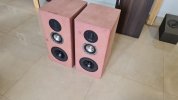
Each speaker with drivers but without crossovers weigh a healthy 14.5 kilos:
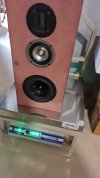
Three pairs of Zantzen binding posts which cost 66% over and above the build of the boxes.
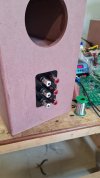
The speakers have been made finally; sans finishing as I'm yet to take a call on going for CLD, which will happen only after detailed audition. Posting some pics:
Fully made speakers:

Each speaker with drivers but without crossovers weigh a healthy 14.5 kilos:

Three pairs of Zantzen binding posts which cost 66% over and above the build of the boxes.

Last edited:
navin advani
Well-Known Member
I'm using Aluminium to add minimum thickness and adding mass as the MDF layer is already 19mm thick. Should work as CLD if I use a damping gel that you had linked earlier.
We haven't come to that yet. And I'm not convinced that adding a 2-3 mm Aluminium layer could be placed inside easily and would have enough efficacy; especially since the braces and mid-range tunnel were already fixed. Also, I need to first evaluate the speakers to decide if they have the refinement levels to benefit from CLD construction.
CLD works best if the stiffness and density of the 2 layers are as different as possible. I have not used Aluminium but I have used closed cell foam, resin bonded fibreglass (FRP) and lead sheet as the CLD layer.Earl Geddes says that the stiffness of the two materials used for CLD is what matters more than the thickness. Maybe if the 3mm aluminum sheet and 19mm MDF have similar stiffness properties, it might work well.
Based on my experiments with closed-cell foam (much lower density and far less stiff than marine-grade ply), FRP (much stiffer than marine-grade ply) and lead sheet (far denser but much softer than marine-grade ply) I would recommend a 5 layer CLD where you have 2 different layers of CLD sandwiched between 3 layers of wood (MDF or ply). See images where both FRP and Lead sheets are used. The total thickness (without veneer) of the cabinet was 23mm (3 layers of 6mm ply, 3mm lead sheet and 2mm FRP). When I used closed cell foam the total thickness was 60mm (2 layers of 20mm of foam and 3 layers of 6mm ply). I'd recommend foam for subwoofers and bass bins (to isolate the inner and outer walls) and FRP and lead sheets for monitors and towers (to mass load the cabinet and reduce system Fs as low as possible).
The images are from 2012 when I built my last pair of speakers (using 2x 18cm ScanSpeak Illuminator woofers, a 50mm Accuton Mid and a RAAL 70-20 tweeter). I did not take pics of the subwoofer (using a 15" TC sounds driver) during the build.
The added advantage of using ply over MDF is that it is easier to bend (and hence pre-stress the wood) if it is ply than MDF.
Hope this helps.
P.S. I am sorry I am not regular on forums or social media so if I miss messages please forgive me.
God bless and stay safe.
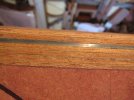
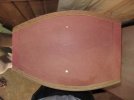
Vineethkumar01
Well-Known Member
Thanks for the clarifications and details of your build.CLD works best if the stiffness and density of the 2 layers are as different as possible. I have not used Aluminium but I have used closed cell foam, resin bonded fibreglass (FRP) and lead sheet as the CLD layer.
Based on my experiments with closed-cell foam (much lower density and far less stiff than marine-grade ply), FRP (much stiffer than marine-grade ply) and lead sheet (far denser but much softer than marine-grade ply) I would recommend a 5 layer CLD where you have 2 different layers of CLD sandwiched between 3 layers of wood (MDF or ply). See images where both FRP and Lead sheets are used. The total thickness (without veneer) of the cabinet was 23mm (3 layers of 6mm ply, 3mm lead sheet and 2mm FRP). When I used closed cell foam the total thickness was 60mm (2 layers of 20mm of foam and 3 layers of 6mm ply). I'd recommend foam for subwoofers and bass bins (to isolate the inner and outer walls) and FRP and lead sheets for monitors and towers (to mass load the cabinet and reduce system Fs as low as possible).
The images are from 2012 when I built my last pair of speakers (using 2x 18cm ScanSpeak Illuminator woofers, a 50mm Accuton Mid and a RAAL 70-20 tweeter). I did not take pics of the subwoofer (using a 15" TC sounds driver) during the build.
The added advantage of using ply over MDF is that it is easier to bend (and hence pre-stress the wood) if it is ply than MDF.
Hope this helps.
P.S. I am sorry I am not regular on forums or social media so if I miss messages please forgive me.
God bless and stay safe.View attachment 67005View attachment 67006
To me your builds and experience building multilayer sandwich constructions is awesome.
For any others interested like me, I am posting this link which shows more pics and gives more details about this build: https://www.audiocircle.com/index.php?topic=110639.0
When I said 'two layers should be having similar stiffness', I was referring to the two constraining layers having similar stiffness. Not the constraining layer and the shearing layer. In above pics, the constraining layers are similar thickness plywood and the FRP and the lead sheets look like the shearing layers. As you said, the constraining and shearing layers should have different physical properties.
I personally have no experience yet in building multilayer cabinets. So I do not know about effectiveness of lead as a shearing layer or its visco-elastic properties. But one thing I can guess is that it will make a very good 'mass-loading' layer.
Thanks a lot for sharing all this information.
I hope it inspires at least a few others also like it inspires me.
Thanks
Vineeth
keith_correa
Well-Known Member
Update:

Looking very good!The speakers have been made finally; sans finishing as I'm yet to take a call on going for CLD, which will happen only after detailed audition. Posting some pics:
Fully made speakers:
Each speaker with drivers but without crossovers weigh a healthy 14.5 kilos:
66% of the cost of building the box?Three pairs of Zantzen binding posts which cost 66% over and above the build of the boxes.
Check out our special offers on Stereo Package & Bundles for all budget types.
Similar threads
- Replies
- 24
- Views
- 9K
- Replies
- 6
- Views
- 5K
- Replies
- 35
- Views
- 8K

